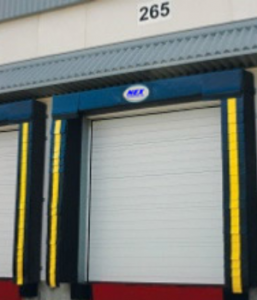It might not seem like a big issue, but every gap, no matter how small around a parked trailer at the loading dock will cost you.

Be it summer or winter these tiny gaps can unnecessarily cost you hundreds of dollars per year. These gaps also can let in outside elements, including dirt, bugs, rodents, birds, dust, wind, rain, and snow. This can result in product damage, negatively impact warehouse inspections, and create an unproductive work environment for your employees.
Nex Industrial supplies, installs, and services loading dock equipment in Vaughan and throughout the GTA; this includes dock seals and dock shelters, to ensure that your facility’s heating and cooling systems stay in check and that nothing gets inside, that’s supposed to stay outside.
Dock shelters and dock seals are both used for environmental control, but they are designed differently to better serve different applications; knowing the differences between them can help determine which better suits your needs. Confused as to what the difference is between dock seals and dock shelters? Keep reading for our breakdown.
Dock Seals
Dock seals are typically foam pads that the trailer compresses into when it backs in and comes to rest against the dock bumpers, forming a seal around the top and sides of the trailer. Dock seals provide an efficient, tight seal for an affordable price. Dock seals are the better choice when there is minor variation in the size trailers and low to medium traffic.
Dock seals can restrict forklift access to the trailer because when the trailer is compressed into the loading dock door, the material from the side pads impedes the trailer opening. Docks seals can wear out easily when loading docks receive heavy traffic. Dock seals do use less space around the outside of the dock then shelters, so with loading docks where space is an issue dock seals are a better choice.
Dock Shelters
Dock shelters are enclosures that seal around the exterior of the back of the trailer. Fabric curtains fitted with supports are used to apply pressure against the sides of the trailer. Shelters fit larger dock door openings better; because of this, they are able to service a bigger variety of trailer heights and styles without suffering wear and tear from daily use. Dock shelters also allow for unobstructed access to the entire trailer opening, allowing for both safety and optimal loading and unloading efficiency.
Dock shelters have improved in terms of design in recent years; in the past, they weren’t able to provide as tight of a seal as dock seals, but newer models now are designed with features that allow them to perform just as effectively of dock seals. As well, some shelters didn’t have effective sealing for the tops of trailers, leaving gaps when the trailer is backed in.
Newer models have options that include seals on the side curtains that cover the hinge-gaps between the doors and trailer-wall, allowing for a complete seal. New models also ensure that the tops of the trailers are tightly sealed with the addition of a weighted top-curtain.
How to Choose
Both dock seals and dock shelters are designed and adaptable to support various applications. Which solution will suit your loading docks most efficiently? We recommend talking with one of our experts, who can analyze your loading dock and give you a recommendation based on your facility’s individual needs.








